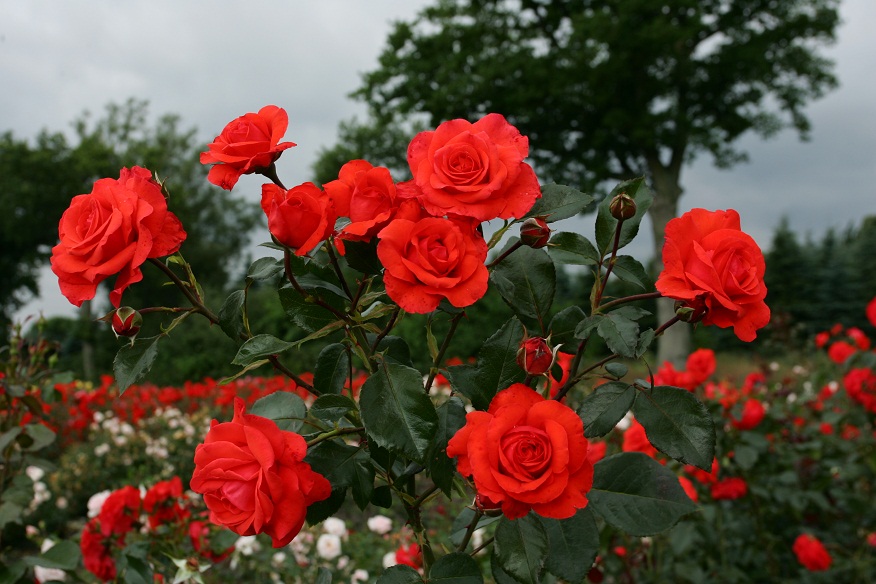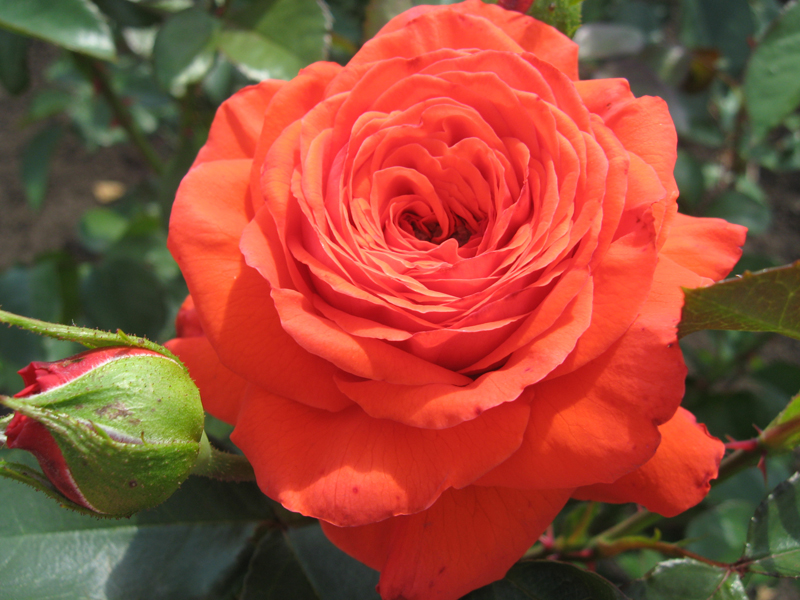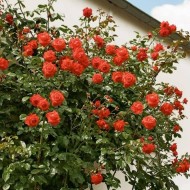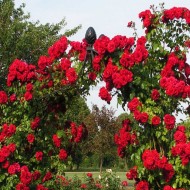What gardeners like the climbing rose Salita: description, reviews and photos
Content
Breeding history
Rosa Salita (Salita), which belongs to the group of climbers, was bred in 1987. The originators of the variety are German breeders working on the basis of the Wilhelm Cordes gardening nursery. The official name of the flower is Rose Salita. In botanical reference books, there is another name for the garden culture - KORmorlet.

Characteristics and description of the Salita rose
Climbing rose Salita is a spreading ornamental shrub, the height of which reaches 3 m. The width of the rose bush is 1.5–2 m. The variety is characterized by long and strong shoots. The leaf plates are large, elliptical widened at the base, dark green in color with a clearly visible sheen.
During the flowering period, which begins in May and lasts until mid-September, the shrub is covered with double flowers with a diameter of 8-9 cm. The flowers have an interesting color: a bright scarlet shade is complemented by coral and orange tones. The buds can form singly or gather in small clusters. A unique feature of the Salita variety is the ability to form peduncles not only at the tops, but also along the entire length of the shoots.
The fragrance is worth mentioning separately. During flowering, the rose bush emits a pleasant and unobtrusive smell, in which fruit and berry notes are clearly captured.

Advantages and disadvantages of the variety
- high decorativeness;
- original fiery color of buds;
- abundant and almost continuous flowering;
- pleasant and unobtrusive aroma;
- excellent adaptive abilities;
- resistance to rain;
- the possibility of using in floristry.
- slow growth in regions with a harsh climate;
- burnout tendency;
- low resistance to pathogens of fungal diseases.
Video "Acquaintance with the climbing rose Salita"
This video presents the key decorative and varietal characteristics of a horticultural culture.
Features of growing Salita roses
The intensity of growth and the duration of flowering of a climbing rose depend on the correctness of agricultural technology.
Purchase and preparation of seedlings
The climbing rose of the Salita variety can be propagated independently. Most often, the methods of grafting and propagation by offspring are used. However, as the gardeners themselves say, with seed and vegetative propagation, there is a slight loss of varietal qualities. Therefore, it is better to grow a crop from a varietal seedling.
Preparatory procedures involve examining the planting material for signs of diseases and pests.Before planting, the root system of the seedling is treated with a weak solution of potassium permanganate and kept in a solution of the growth biostimulator "Zircon" or "Heteroauxin".

Site selection, soil and planting
Salita likes adequate lighting. But prolonged contact with direct sunlight leads to burnout of the buds and the appearance of burn spots on the leaves. You need to grow a rose in partial shade. In this case, it is desirable to protect the plant from wind and draft. Protective structures can be fences or walls of houses and outbuildings.
A light, breathable, fertile environment is suitable for growing the variety. Heavy soils interfere with the normal development of culture, light soils let moisture through like a sieve. The most successful option is nutrient-rich black soil or loam with a soil reaction of 5.6 to 6.5 pH.
It is better to plant a seedling in open ground in the middle of spring. Autumn planting is allowed in the southern regions of Russia, but the procedure must be carried out no later than the end of September. When planting roses, they must form a drainage system: the bottom of the planting pit is laid out with gravel, crushed stone or broken brick. The height of the layer is about 10 cm.
To increase the fertility of the soil, organic fertilizers are applied. If peat, rotted manure or compost were added to the hole at the time of planting, the rose bush is not fertilized for the first few years. The final stages of planting are abundant watering and mulching of the trunk circle.
The nuances of growing
The frequency of watering and the volume of water depend on the amount of precipitation and temperature conditions. During a dry period, the plant is moistened at least 3 times a week. At low air temperatures and frequent precipitation, the number of irrigations is reduced. If the topsoil is dry, it's time for the next moisture. On average, one bush requires 15–20 liters of water at room temperature.
For normal growth and development of the shrub, shallow loosening of the soil is carried out, which contributes to better air circulation. Mulching the soil saves the rose from weeds and helps maintain optimal moisture levels in the tree trunk circle.
The first year after planting in a permanent place of growth, it is recommended to remove all buds that are tied. It is believed that a young plant that has spent energy on flowering will not cope with the first winter. In the future, the bush is pruned in moderation, keeping the basal shoots of the first order. Below is the optimal pruning scheme for a climbing rose of a group of climbers.

They begin to cover the rose bush when the air temperature drops to -7 ° C. The branches are neatly bent to the surface of the earth, collected in bunches, fixed with metal arcs or frame structures and covered with pine spruce branches. Spunbond can be used instead of spruce branches.
Common diseases and pests
Salita is rarely affected by harmful insects. In order to prevent the appearance of pests, the shrub is periodically sprayed with ivy decoction or soap and garlic solution. The soil in the near-trunk circle is sprinkled with tobacco dust.
Excess moisture in the soil and a strong thickening of the crown can cause the development of powdery mildew or black spot. The most effective way to deal with ailments with the help of fungicidal preparations "Fitosporin-M", "Abiga-Peak", "Oksikhom", "Baylon", "Skor", etc.
The use of the Salita rose in landscape design
Climbing roses of the group of climbers are used for vertical landscaping and decoration of garden arbors, arches, columns and walls of buildings. The flower can be used to decorate poles, lanterns, wrought-iron fences, garden furniture and artificial compositions.
Rose Salita does not require adjacent crops. A bright and spectacular flower looks interesting in solitary plantings.In the case of group plantings, annual ground covers, conifers and evergreens will be the best companions.
Salita is in harmony with phlox, verbena, ageratum, alyssum and other ground covers with white flowers.
- Decorating the walls of houses and outbuildings
- Decoration of forged decorative elements
- Application in vertical gardening
Variety reviews
“I have been growing rose bushes for many years. During this time, I managed to get acquainted with many varieties, but one of the most beloved is Salita. The rose has relatively low maintenance requirements, grows well and blooms profusely. "
“I grow in the garden various types and varieties of decorative flowering crops, among which is the Salita rose. Due to the climatic features of our region, we had to spend time choosing the most successful place for planting a plant. The flower pleases with annual flowering and pleasant aroma ”.
Climbing rose Salita is considered one of the most unpretentious climbers in growing. Subject to the watering regime, correct pruning and wintering, it can be cultivated in almost all regions of Russia.



